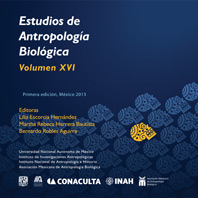Preliminar essay of human and animal skeletal remains analysis
DOI:
https://doi.org/10.22201/iia.14055066p.2013.56676Keywords:
archaeozoology, Maya, human remains, worked bone, trashAbstract
The Nueva Esperanza archaeological site, located in the southern state of Quintana Roo, was continuously occupied from the Preclassic to the Postclassic. In the 2010 field season, four wells were dug; in the 8 and 9, remains were found, which were analyzed in the laboratory Maya Archaeology of South of Quintana Roo and Campeche, with a degree in Archaeology from the National School of Anthropology and History. This paper shows the results of the analysis of 327 bones, human and non human alike, and its cultural implications. In short, within the collection were found bones with evidence of natural processes and cultural changes. Within the first, the most common are weathering and brands roots, in the letter, cutting traces and heat treatment, which would indicate aspects of diet and food preparation within the site. In addition, worked bone provides data on production and possible role of the artifacts found in the collection. The taxonomic identification of faunal remains allowed comparison with other samples in the Maya area.
Downloads
Downloads
Published
How to Cite
Issue
Section
License

http://creativecommons.org/licenses/by-nc-nd/4.0/


